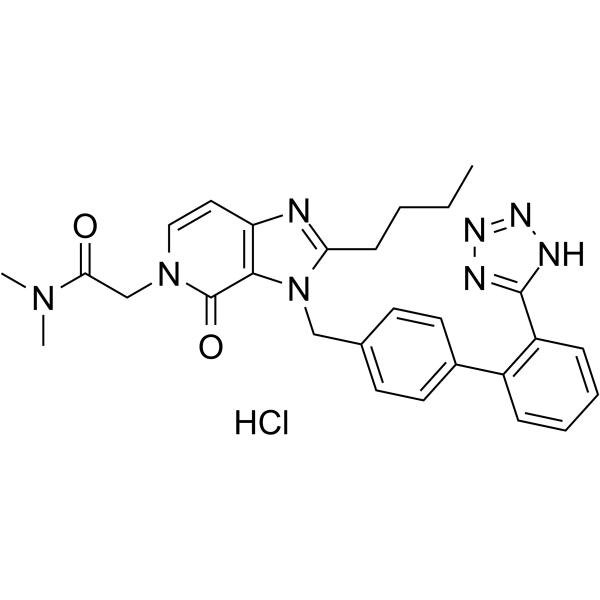| Description |
EMD 66684 is an antagonist of Angiotensin II Type 1 (AT1) receptor. EMD 66684 shows potent binding affinities for the AT1 subtype Ang II receptor with an IC50 value of 0.7 nM. EMD 66684 also serves as an antiischemic cytoprotectant [1]-[5].
|
| Related Catalog |
|
| Target |
Ang II receptor:0.7 nM (IC50)
|
| In Vitro |
Ang II is known to activate at least two receptor subtypes, namely, AT1 and AT2 receptors[1]. EMD 66684 (0.1 μM) decreases Ang II (0.1 mM)-induced in basal and NS-induced NPY overflow, attenuates the NS-induced stimulation of both NE and NPY release[1]. EMD 66684 (0.01 nM-1 μM; 0, 30, 60 min) exhibits a time-dependent inhibition against Ang II in DMR (dynamic mass redistribution) responses, with IC50s of 181.97 nM (0 min), 0.22 nM (30 min), 0.17 nM (60 min), respectively[2]. EMD 66684 exhibits binding affinities for the AT1 subtype Ang II receptor with an IC50 value of 0.7 nM in rat adrenal cortical membranes, and inhibits Ang II-Induced contraction in rabbit aortic rings with an IC50 value of 0.2 nM[3]. Cell Viability Assay[1] Cell Line: Hep G2 cells (liver hepatocellular carcinoma cell line) Concentration: 1 nM Incubation Time: 1 hour Result: Completely blocked the Ang II responses Ang II-induced response.
|
| In Vivo |
EMD 66684 (0.1, 0.3, 1 mg/kg; i.v.; once) results in a long lasting fall in blood pressure[3]. EMD 66684 (0.1 μM; 45 min) decreases the NS-induced overflow of NE and NPY from preparations from SHRs at 10-12 weeks old[4]. Animal Model: Conscious furosemide-treated SHR (Spontaneous Hypertension Rat)[3] Dosage: 0.1, 0.3, 1 mg/kg Administration: Intravenous injection; once; as potassium salts to conscious furosemide-treated SHR Result: Showed a long lasting fall in blood pressure, resulted mean arterial pressure (MAP) decreased in a dose-dependent manner.
|
| References |
[1]. Westfall TC, et al. Interactions of neuropeptide y, catecholamines, and angiotensin at the vascular neuroeffector junction. Adv Pharmacol. 2013;68:115-39. [2]. Qu L, et al. Systematic characterization of AT1 receptor antagonists with label-free dynamic mass redistribution assays. J Pharmacol Toxicol Methods. 2020 Mar-Apr;102:106682. [3]. Mederski WW, et al. Non-peptide angiotensin II receptor antagonists: synthesis and biological activity of a series of novel 4,5-dihydro-4-oxo-3H-imidazo[4,5-c]pyridine derivatives. J Med Chem. 1994 May 27;37(11):1632-45. [4]. Byku M, et al. Nerve stimulation induced overflow of neuropeptide Y and modulation by angiotensin II in spontaneously hypertensive rats. Am J Physiol Heart Circ Physiol. 2008 Nov;295(5):H2188-97. [5]. Avkran M, et al. Treatment of ischemia with an angiotensin II antagonist: UK, GB2337701. 1999-12-01.
|
